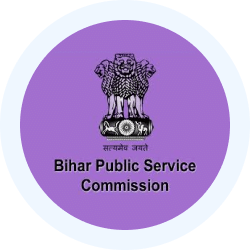BPSC Monthly Current Affairs: March 2025 | Monthly Current Affairs BPSC - BPSC (Bihar) PDF Download
Special Economic Zones (SEZ) in Buxar and West Champaran
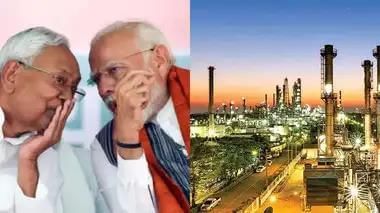
Why in News?
Bihar's Industry Minister has announced the establishment of Special Economic Zones (SEZs) in Buxar and West Champaran. The central government has given approval for setting up these zones by November 2024. The SEZs are planned to be located in Navanagar, Buxar, and Kumarbagh, West Champaran.
What are Special Economic Zones (SEZs)?
- SEZs are designated areas within a country that offer special benefits, such as duty-free incentives and different trade regulations.
- The primary purpose of SEZs is to attract investment and generate employment opportunities.
- These zones aim to enhance the management of these areas, facilitating smoother business operations.
SEZs in India: A Brief History
- The concept of Export Processing Zones (EPZs), similar to SEZs, was introduced in India to address infrastructure and bureaucratic challenges.
- The first EPZ in Asia was established in Kandla, Gujarat, in 1965.
- The Special Economic Zone Act was enacted in 2005, coming into effect in 2006.
- Currently, India has 379 notified SEZs, out of which 265 are operational.
- A significant portion (about 64%) of SEZs is concentrated in five states: Tamil Nadu, Telangana, Karnataka, Andhra Pradesh, and Maharashtra.
- The Board of Approval, led by the Secretary of the Department of Commerce, is the primary governing body for SEZs in India.
- In 2018, a committee headed by Baba Kalyani reviewed India's SEZ policy and made recommendations for improvement.
Role of the World Trade Organization (WTO)
- The WTO was involved in assessing India's SEZ policy to ensure it aligns with global best practices.
- The aim is to maximize the potential output and effectiveness of SEZs in India.
Vikramshila University: Revival of a Historical Educational Centre
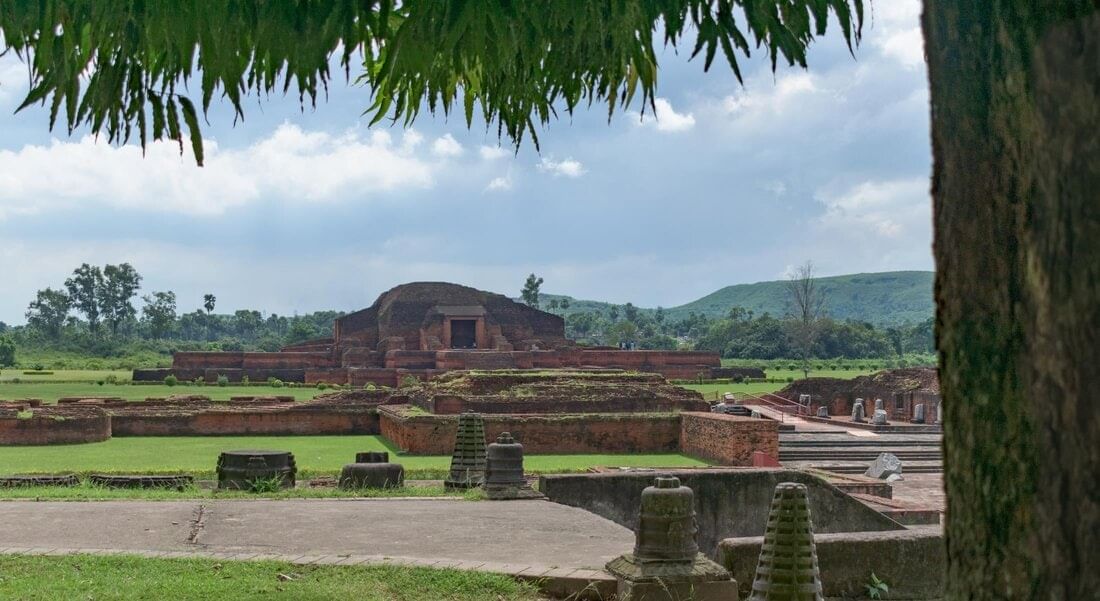 Vikramshila Ruins
Vikramshila Ruins
Why in News?
The initiative to revive Vikramshila University comes a decade after the establishment of Nalanda University in Rajgir, Bihar. The Archaeological Survey of India (ASI) has been working on enhancing the Vikramshila site since December 2024 to attract more tourists.
About the Project:
- The Vikramshila University project was approved by the Centre in 2015 with a funding of Rs 500 crore. However, progress was hindered due to delays in land identification by the Bihar government.
- On 24th February 2025, the Prime Minister emphasized the government's commitment to reviving Vikramshila, underlining its potential as a global knowledge hub.
Archaeological Conservation and Preservation
- Workers are actively involved in clearing vegetation and uncovering architectural details at the Vikramshila Mahavihar ruins.
- The site is being systematically organized into grids as part of the ASI's conservation efforts.
Historical Significance of Vikramshila
- Vikramshila was established by Pala King Dharmapala in the late 8th to early 9th century AD and coexisted with Nalanda University.
- While Nalanda offered a broad range of subjects, Vikramshila specialized in tantric and occult studies.
- Under Dharmapala's rule, Vikramshila was the preeminent institution, even overseeing Nalanda at times.
- Both universities shared a patron and exchanged scholars known as Acharyas.
Academic Excellence and Global Influence
- Vikramshila offered courses in theology, philosophy, grammar, metaphysics, and logic, with a primary focus on Tantrayana Buddhism.
- One of its notable scholars, Atisa Dipankara, played a crucial role in spreading Buddhism to Tibet.
- The university flourished for nearly four centuries before its decline in the 13th century, attributed to the rise of Hinduism, the decline of Buddhism, and invasions by Turkish ruler Qutbuddin Aibak.
Modern Revival Efforts
- The Bihar government has earmarked Rs 87.99 crore for land acquisition in Antichak village, located 3 km from the ancient Vikramshila site.
- The Bhagalpur district administration has identified 202.14 acres for the new Central university, with 27 acres currently occupied by local families.
Nalanda University
- Gupta Emperor Kumaragupta founded Nalanda University in 427 CE in modern Bihar, and it flourished for 600 years until the 12th century.
- Palas During the time of Harshavardhana and his successors, it gained popularity.
- Durring King Harshavardhana’s reign (606-647 AD), Chinese scholar Xuan Zang studied here for about 5 years and brought back many scriptures which were translated into Chinese.
- In 670 AD, another Chinese pilgrim, I-Tsing, visited Nalanda and noted it had 2,000 students supported by funds from 200 villages.
- A large number of students came from China, Mongolia, Tibet, Korea, and other Asian countries.
- Archaeological evidence indicates contact with the Indonesian Shailendra dynasty, whose king built a monastery at the site.
- Spiritual figures like Lord Buddha and Lord Mahavira meditated in this area, adding to its positive atmosphere.
- Great scholars such as Nagarjuna, Aryabhatta, and Dharmakirti contributed to the academic traditions of ancient Nalanda.
- The university was destroyed in 1193 by Bakhtiyar Khilji, a general of Turkish ruler Qutbuddin Aibak.
- It was rediscovered in 1812 by Scottish surveyor Francis Buchanan-Hamilton, and later identified as the ancient university by Sir Alexander Cunningham in 1861.
Bihar Diwas
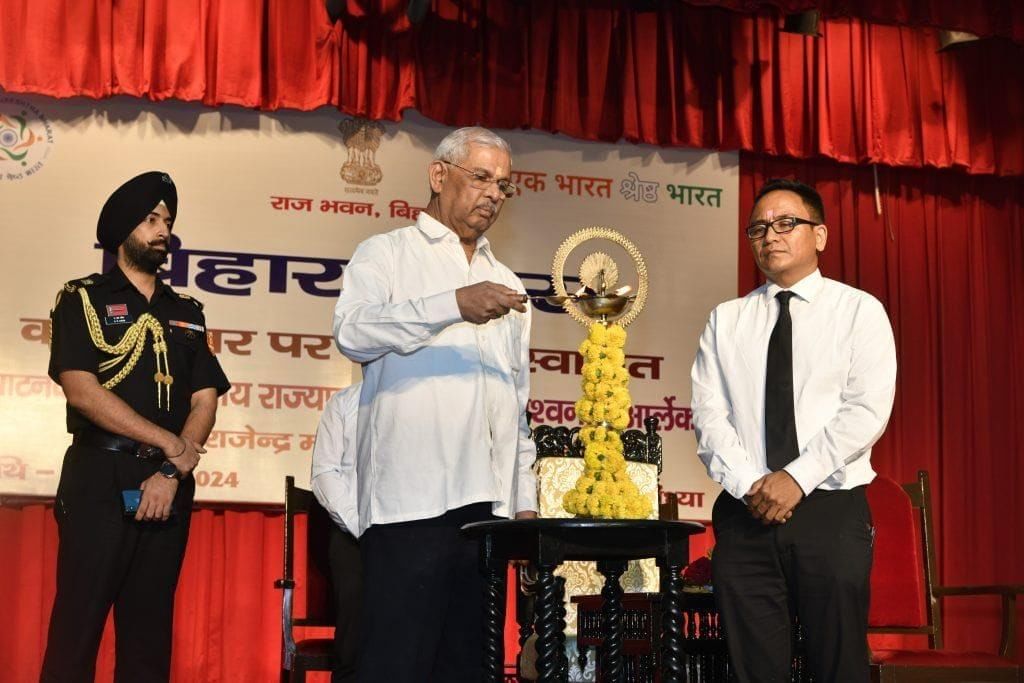 Bihar Diwas Celebration
Bihar Diwas Celebration
Why in News?
From March 22 to 24, 2025, a three-day event was held at Gandhi Maidan in Patna to celebrate Bihar Diwas, which is observed annually on March 22.
About the function:
- The primary goal of this celebration is to acknowledge and honor the rich cultural heritage, history, and development of Bihar.
- This year marked the 113th foundation day of Bihar, with the theme 'Advanced Bihar, Developed Bihar'.
- Various departments, including the Education Department, Rural Development, Art, Culture and Youth Department, and Disaster Management, organized an exhibition to showcase development projects.
- During the event, the Chief Minister launched two important booklets: 'Disaster Risk Reduction Roadmap of Bihar' and 'Chief Minister School Safety Program'.
History of Bihar Day:
- On March 22, 1912, the British separated Bihar from Bengal, creating the new province of Bihar.
- The Bengal Partition in 1905, which sparked the Swadeshi movement, was reversed, leading to the formation of Bihar and Assam.
- In 2000, Bihar was divided, and the new state of Jharkhand was carved out.
- In 2011, Chief Minister Nitish Kumar formalized Bihar Day as a comprehensive celebration, making it a public holiday in the state.
- Bihar Day is now celebrated not only in India but also in various countries, including the United States, Germany, Britain (Scotland), Australia, Canada, Bahrain, Qatar, the United Arab Emirates, Trinidad and Tobago, and Mauritius.
Bihar State
About:
- The name 'Bihar' is thought to originate from the numerous Buddhist monasteries (Viharas) that once thrived here, as this region was a significant center for Buddhism in ancient times.
- The state's capital is Patna, which has been known historically as Pataliputra, Pushpapur, and Kusumpur.
Geographical Location:
- Bihar is situated between 24°20'10" to 27°31'15" north latitude and 83°19'50" to 88°17'40" east longitude.
- The state's total area is 94,163 square kilometers, making it the 13th largest state in India.
- This area accounts for 2.86% of India's total geographical expanse.
- Bihar stretches 345 kilometers from north to south and 483 kilometers from east to west.
- The largest district by area is West Champaran, while the smallest is Sheohar.
Boundaries:
- Bihar shares its borders with three states: West Bengal, Uttar Pradesh, and Jharkhand, as well as with the neighboring country of Nepal.
- Seven districts in Bihar share a border with Nepal: West Champaran, East Champaran, Sitamarhi, Madhubani, Supaul, Araria, and Kishanganj.
- Eight districts border Uttar Pradesh: Rohtas, Kaimur, Buxar, Bhojpur, Saran, Siwan, Gopalganj, and West Champaran.
- Three districts connect with West Bengal: Kishanganj, Purnia, and Katihar.
- Eight districts connect with Jharkhand: Bhagalpur, Banka, Jamui, Nawada, Gaya, Aurangabad, Rohtas, and Katihar.
- The northernmost district is West Champaran, the southernmost is Gaya, the westernmost is Kaimur, and the easternmost is Kishanganj.
Special Category Status for Bihar
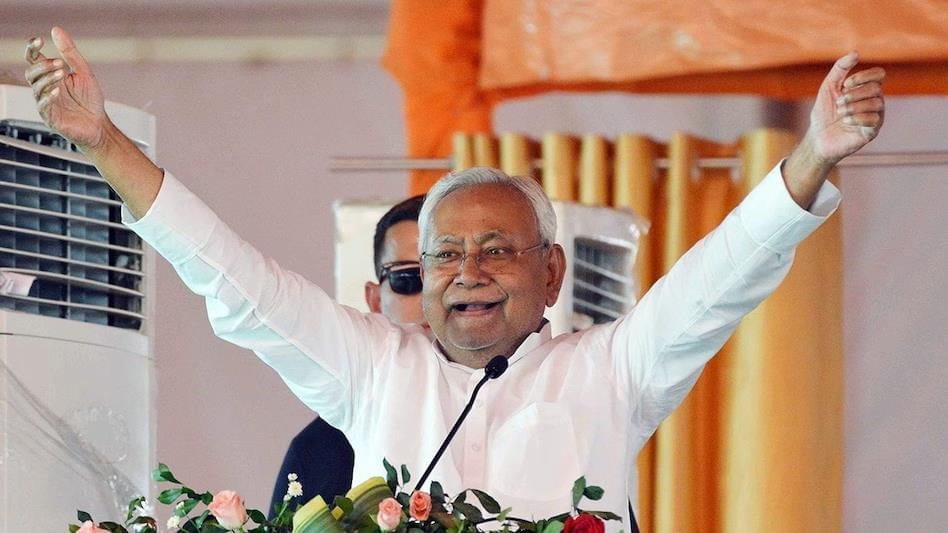
Why in News?
Bihar has once again requested this important status, which would help boost the state’s tax income from the Centre.
Special Category Status
- Historical and structural challenges: Bihar struggles with economic issues, including limited industrial growth and few investment chances.
- Employment and economic development: After the state's division, many industries moved to Jharkhand, worsening the situation.
- Natural Calamities: The state deals with severe problems like floods in the north and droughts in the south.
- Agricultural activities: These disasters disrupt farming, especially irrigation, leading to poor water supply and affecting livelihoods.
- Lack of Infrastructure: Bihar’s poor infrastructure slows development, with issues like bad roads, limited healthcare, and few educational services.
- The Raghuram Rajan Committee: In 2013, this committee, set up by the Centre, classified Bihar as “least developed.”
- Poverty and Social Development: Bihar has a high poverty rate, with many families living below the poverty line.
- NITI Aayog:. survey by NITI Aayog revealed that Bihar is the poorest state, with a multidimensional poverty rate of 26.59% in 2022-23, much higher than the national average of 11.28%.
- Gross Domestic Product (GDP): Bihar’s per capita GDP for 2022-23 is only Rs 60,000, compared to the national average of Rs 1,69,496.
Special Category Rating
- Special Category Status (SCS) is a classification given by the Centre to support the development of regions that are geographically and socio-economically disadvantaged.
- This status was not originally in the Constitution; it was established in 1969 following the Fifth Finance Commission's recommendations.
- The first states to receive SCS were Jammu and Kashmir, Assam, and Nagaland in 1969, with Telangana being the latest.
- SCS differs from special status, which involves greater legislative and political rights, while SCS focuses on economic and financial support.
- For instance, Jammu and Kashmir had special status before the removal of Article 370.
- Criteria for SCS:
- Mountainous terrain
- Low population density and/or a large tribal population
- Strategic location on borders with neighbouring countries
- Backwardness in economic development and infrastructure
- Unsustainable financial situation due to low revenue generation
- Benefits:
- 90% of the funds required for centrally sponsored schemes are allocated to special category states, compared to 60% or 75% for others.
- Unspent funds in a financial year can be carried over to the next year.
- These states receive substantial reductions in excise and customs duties, income tax, and corporate tax.
- 30% of the Centre’s total budget is allocated to special category states.
Bihar Honored at the Digitech Awards 2025
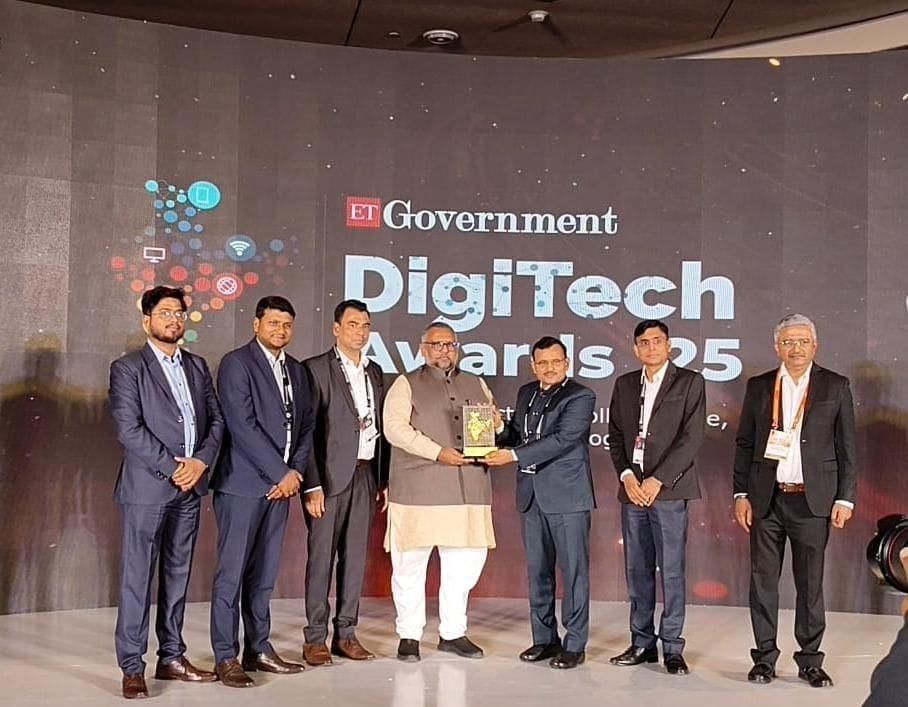
Why in News?
Bihar has been recognized with a prestigious Gold Award at the Government Digitech Awards 2025 for its innovative use of Smart Prepaid Meters. This award highlights the state’s commitment to digital transformation in public services.
Bihar’s Achievement in Smart Prepaid Metering
- The Gold Award was presented to Bihar State Power Holding Company Limited (BSPHCL) for their successful implementation of smart prepaid metering systems.
- Bihar’s initiative, titled ‘Bihar - Proud Torch Bearer of Universal Smart Prepaid Metering for the Nation,’ was recognized as the best Digital Transformation Leader in the Public Sector category.
- Smart prepaid metering is an advanced energy management system that offers greater transparency, efficiency, and user-friendliness compared to traditional metering methods.
- The objectives of smart prepaid metering include:
- Empowering consumers with better control over their energy usage.
- Increasing transparency in billing processes.
- Promoting energy conservation.
- Enhancing revenue recovery for service providers.
The ‘Bihar Krishi’ App
- The Agriculture Department of Bihar was also recognized with a Gold Award for the successful implementation of the ‘Bihar Krishi’ App.
- This app serves as a comprehensive digital platform for farmers, providing them with essential information and services, including:
- Access to various agriculture schemes.
- Real-time crop prices.
- Weather updates relevant to agricultural activities.
- Grievance redressal mechanisms for farmers.
- Soil health card information to promote sustainable farming practices.
- Government announcements related to agriculture.
- Contact details for agriculture-related services and support.
About the Government Digitech Awards
- The ET Government Digitech Awards are organized with the support of the Union Ministry of Electronics and Information Technology.
- These awards aim to recognize and honor individuals and organizations that have made significant contributions to the digital transformation of public services.
- At the 2025 event, a total of 30 winners from across India were acknowledged for their outstanding efforts.
- Other states, including Gujarat, Madhya Pradesh, Rajasthan, Uttar Pradesh, Telangana, Odisha, Kerala, Tripura, West Bengal, and Haryana, also received awards in various categories for their digital initiatives.
Task Force to Eradicate Child Marriage
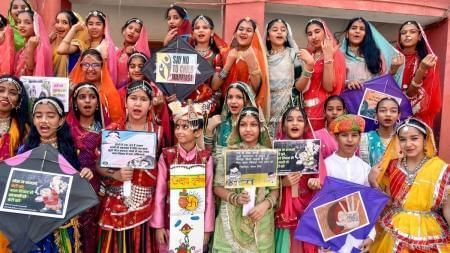
Why in News?
The Bihar government is setting up a state-level task force led by the Chief Secretary to prevent child marriage in the state.
Objectives and functions of the Task Force:
- To guide the police and other agencies effectively in preventing child marriage.
- To ensure strict handling of cases under the Prohibition of Child Marriage Act (PCMA).
- To improve coordination between Child Marriage Prohibition Officers (CMPO) and the Special Juvenile Police Unit (SJPU).
- To appoint Child Marriage Protection Officers at every district and sub-division level.
Status of child marriage in the state:
- National Family Health Survey (NFHS)-5: Bihar ranks second after West Bengal for child marriage rates.
- According to the report, 40.8% of women in the state marry before the age of 18.
Other efforts to eradicate child marriage:
- The Beti Bachao, Beti Padhao campaign.
- Interactive meetings with girl students in schools under the Informer Incentive Scheme.
- A cash reward of up to Rs 5000 for verified information under the scheme.
- Organising awareness camps in rural areas to educate the community about the harmful effects of child marriage.
Beti Bachao, Beti Padhao Campaign
- Launched in January 2015 to combat sex-selective abortion and the declining child sex ratio, which was 918 girls for every 1,000 boys in 2011.
- This is a joint initiative of the Ministry of Women and Child Development, Ministry of Health and Family Welfare, and Ministry of Human Resource Development.
- The programme is implemented across 405 districts in the country.
Prohibition of Child Marriage Act, 2006
The Prohibition of Child Marriage Act, 2006 is a law by the Government of India aimed at preventing child marriage.
Key provisions of the Act:
- Marriages of men below 21 years or women below 18 years are considered child marriages.
- Child marriage is a punishable offence under this Act.
- Adults who conduct child marriages face up to two years of rigorous imprisonment or a fine up to one lakh rupees, or both; women are not imprisoned.
- Offences under this Act are cognizable and non-bailable.
- The Act allows for declaring the marriage of a minor child as invalid.
Shaurya Vedanam Festival
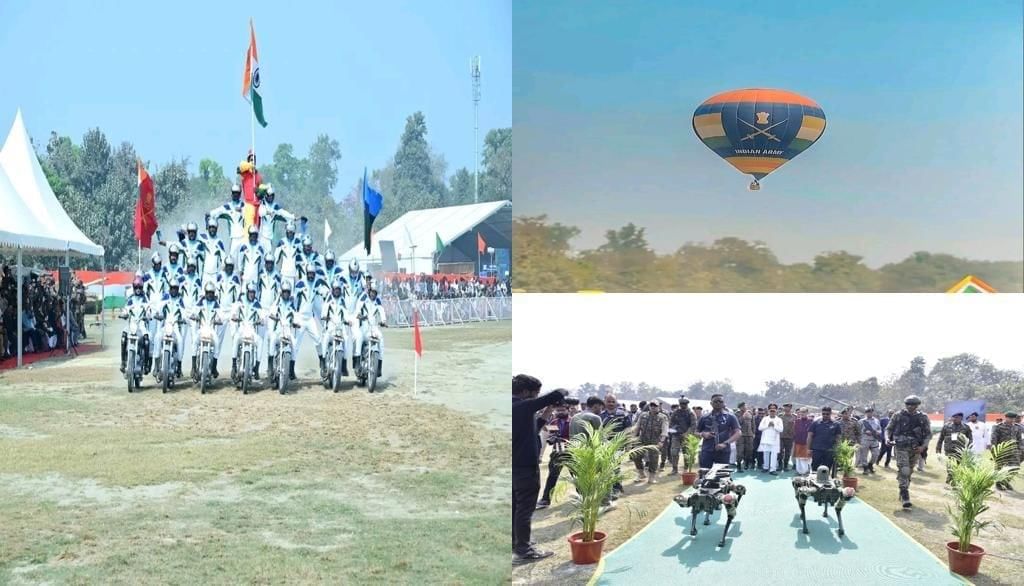 Military Festival
Military Festival
Why in News?
The inaugural Shaurya Vedanam festival took place in Motihari, located in the East Champaran district of Bihar, on the 7th and 8th of March, 2025.
Purpose of the Festival
- The festival was organized with the goal of showcasing military strength and encouraging youth and citizens to connect with and engage in activities related to the defence forces.
Events and Chief Guests
- The festival was a collaborative effort involving the Ministry of Defence and the East Champaran District Administration.
- It was formally inaugurated by Bihar Governor Arif Mohammad Khan.
- Notable chief guests included Radha Mohan Singh (Chairman of the Parliamentary Standing Committee on Defence) and Lt Gen Anindya Sengupta, along with other senior officials.
Military Exhibits and Attractions
- The festival featured a wide range of modern military technologies and equipment from the Army, Navy, and Air Force, including:
- Indian Army. Advanced equipment on display included the K-9 Vajra gun, T-90 Bhishma tank, Swati radar, and BMP combat vehicle.
- Indian Navy. Models of various naval vessels such as submarines, destroyers, and aircraft carriers were showcased.
- Indian Air Force. The Air Force demonstrated its capabilities through a flypast and displays of fighter jets and helicopters.
Overview of Motihari
- Motihari is a historically significant town situated in the East Champaran district of Bihar.
- The town serves as the administrative headquarters of East Champaran district and is located near the border with Nepal.
- According to local legend, the name "Motihari" is derived from two individuals, Moti Singh and Hari Singh.
- Motihari is notably recognized as the birthplace of the famous writer George Orwell and as a key location for Mahatma Gandhi’s Champaran Satyagraha, a significant event in India's struggle for independence.
Scenic Attractions in Motihari
- Kesaria Buddhist Stupa. This stupa, located in Kesaria, is renowned for being one of the tallest Buddhist stupas globally.
- Ashoka Pillar. Situated in Lauriya village, this impressive 36½ feet high pillar was installed by Emperor Ashoka in 249 BC. It is also referred to as Sthamb Dharma Lekh.
Valmiki Mahotsav 2025
 Valmiki Mahotsav
Valmiki Mahotsav
Why in News?
On 8 March 2025, the Chief Minister of Bihar launched the Valmiki Mahotsav 2025.
About the festival:
- Valmiki Mahotsav is a platform to honour the contributions of Maharishi Valmiki and to preserve the rich cultural heritage of Bihar.
- The festival took place at the River Valley Project School, located within the Valmiki Tiger Reserve in Valmikinagar, West Champaran district.
- The event began with a performance of the Bihar Geet, followed by a short film showcasing Maharishi Valmiki and the significance of this sacred site.
- Notable guests, including the Chief Minister of Bihar and the Minister of Art and Culture, attended the event.
- Maharishi Valmiki is regarded as the first poet of Sanskrit literature and the author of the epic Ramayana.
- He was a sage, ascetic, and philosopher, originally a robber who became a saint through the inspiration of sage Narada.
- During his penance, an ant mound, or Valmiki, formed around him, leading to his name.
- He was born on the full moon day of the Ashwin month, which is celebrated as Valmiki Jayanti in the Hindu calendar.
Valmiki Tiger Reserve ( VTR )
- VTR is a key tiger reserve in Bihar, located at the eastern edge of the Himalayan foothills forests in India.
- It lies in the West Champaran district, bordering Nepal to the north and Uttar Pradesh to the west.
- The reserve is part of the Gangetic plains biogeographical region, featuring vegetation from both Bhabar and Terai areas.
Forest Survey of India report 2021
- According to the report, 85.71% of the total area of VTR is forested.
- Wild mammals in the reserve include tigers, wild dogs, bison, and wild boar.
- The rivers Gandak, Pandai, Manor, Harha, Masan, and Bhapsa flow through various parts of the sanctuary.
Bihar Budget 2025-26
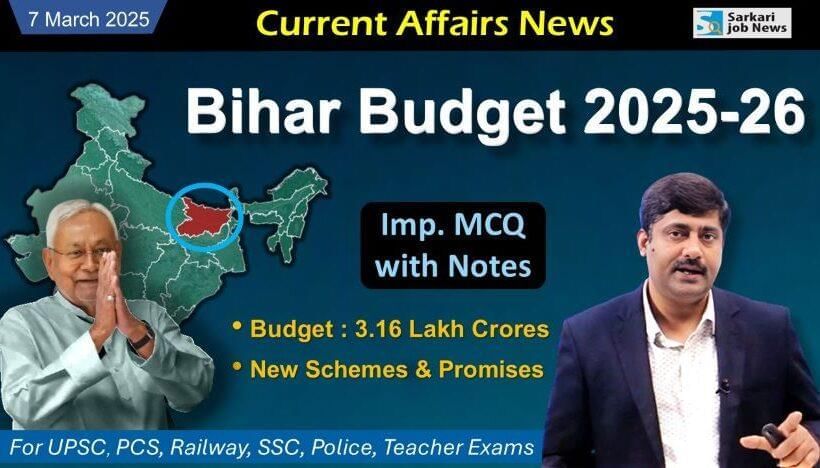 Bihar Budget 2025-26
Bihar Budget 2025-26
Why in News?
On March 3, 2025, Bihar's Finance Minister presented a budget of Rs 3.17 lakh crore for the financial year 2025-26, focusing on education and women’s empowerment.
Key Highlights:
- Revenue Expenditure: Estimated at Rs 2.52 lakh crore, constituting 79.52% of the total budget.
- Education: Highest allocation of Rs 60,964 crore.
- Health: Rs 20,000 crore allocated.
- Infrastructure: Rs 17,000 crore for roads.
- Home Department: Rs 17,831 crore.
- Rural Development: Rs 16,043 crore.
- Energy Department: Rs 13,484 crore.
- Social Welfare: Over Rs 13,000 crore for various social schemes.
Focus on Women Empowerment:
- Pink Toilets: Construction to enhance sanitation for women.
- Mahila Haats: Establishment in Patna to support women vendors.
- Pink Bus Service: Launch of a bus service operated entirely by women.
- Working Women Hostels: Construction to provide safe accommodation.
- Women Tourist Guides: Appointment to promote tourism and provide employment.
- E-Rickshaw Financial Assistance: Support for women to purchase e-rickshaws.
- Women Police Personnel: Increase in number to enhance safety and security.
- Kanya Vivah Mandap: Construction for aiding the marriage of poor girls.
Education and Social Welfare:
- Doubling of scholarship rates for SC/ST and backward classes.
- Increase in incentive amounts for various social welfare schemes.
Health and Medical Facilities:
- Construction of a Cancer Hospital in Begusarai.
- Opening of 108 new urban medical centres across Bihar.
- Establishment of special care centres for cancer patients.
Infrastructure and Transportation:
- Purnia Airport: Construction to enhance air travel.
- New Airports: Development of 8 new airports including Rajgir, Sultanganj, Raxaul, and Madhubani.
- Women Reservation:33% reservation for women in Bihar State Road Transport Corporation.
Environment and Clean Energy:
- Air Quality Improvement: Investment of Rs 1 crore.
- Solar Plants: Installation along canal banks at a cost of Rs 25 crore.
Agriculture and Rural Development:
- Empowerment of market committees for better management.
- Opening of stalls for selling vegetables at the block level.
- Formation of vegetable production committees in all blocks to promote local production.
Migrant Biharis and Tourism:
- Establishment of help centres in various cities for migrant Biharis.
- Government assistance for home-stay facilities during Chhath Puja to promote tourism.
Industry and Trade:
- Promotion of biogas plants as a sustainable energy source.
- Introduction of a new incentive policy for pharmaceutical manufacturing companies to boost local production.
Pradhan Mantri Awas Yojana Rural
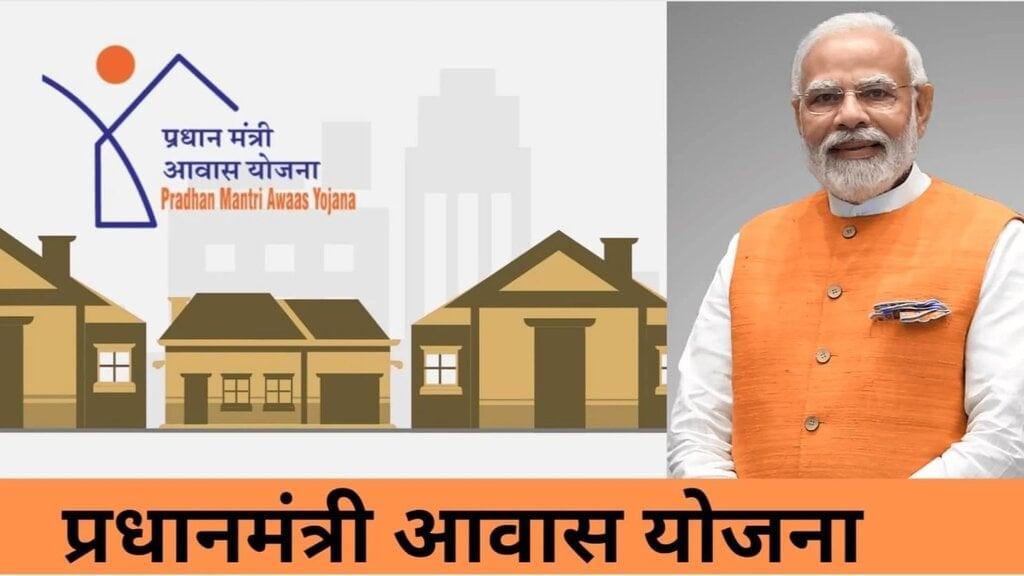 Housing Assistance
Housing Assistance
Why in News?
Recently, the Chief Minister of Bihar transferred an assistance amount of Rs 1,200 crore as the first instalment for three lakh families under the Pradhan Mantri Awas Yojana – Gramin. The beneficiaries will receive another 80 thousand rupees in the form of second and third instalments in the next hundred days.
MNREGA
- Apart from this, Rs 22,050 will be provided as unskilled labour for 90 days through MNREGA.
- Rs 12,000 will be provided for toilet construction under the Lohia Swachh Bihar Abhiyan.
Pradhan Mantri Awas Yojana – Gramin ( PMAY-G )
- Indira Awas Yojana ( IAY )
- Launch : To achieve the goal of “ Housing for All ” by the year 2022, the previous rural housing scheme was restructured into Pradhan Mantri Awas Yojana – Gramin as a Centrally Sponsored Scheme from 1 April 2016.
- Ministry Involved : Ministry of Rural Development.
- Status : States/ UTs have sanctioned 2.85 crore houses to beneficiaries and 2.22 crore houses have been completed till March 2023.
- Objective : To provide pucca houses with basic amenities to all rural families who are homeless or living in kutcha or dilapidated houses by the end of March 2022.
- To provide full grants to rural people for constructing new housing units and upgrading existing unusable kutcha houses.
Scheduled Castes / Scheduled Tribes
- Beneficiaries include :
- Freed bonded labourers and persons belonging to non- SC / ST categories, widows or next of kin of defence personnel killed in war, ex-servicemen and retired members of paramilitary forces, persons with disabilities, and minorities.
Geo-tagging
- Selection of Beneficiaries : A three-step verification process is used, involving the Socio-Economic Caste Census 2011, Gram Sabha, and other relevant criteria.
- Cost Sharing : The Centre and the States share the expenditure in a ratio of 60: 40 in plain areas and 90: 10 in North-Eastern States, two Himalayan States, and the Union Territory of Jammu & Kashmir.
- In other Union Territories, including the Union Territory of Ladakh, the Centre bears 100 % of the cost.
Commemoration of Dr. Rajendra Prasad's Death Anniversary
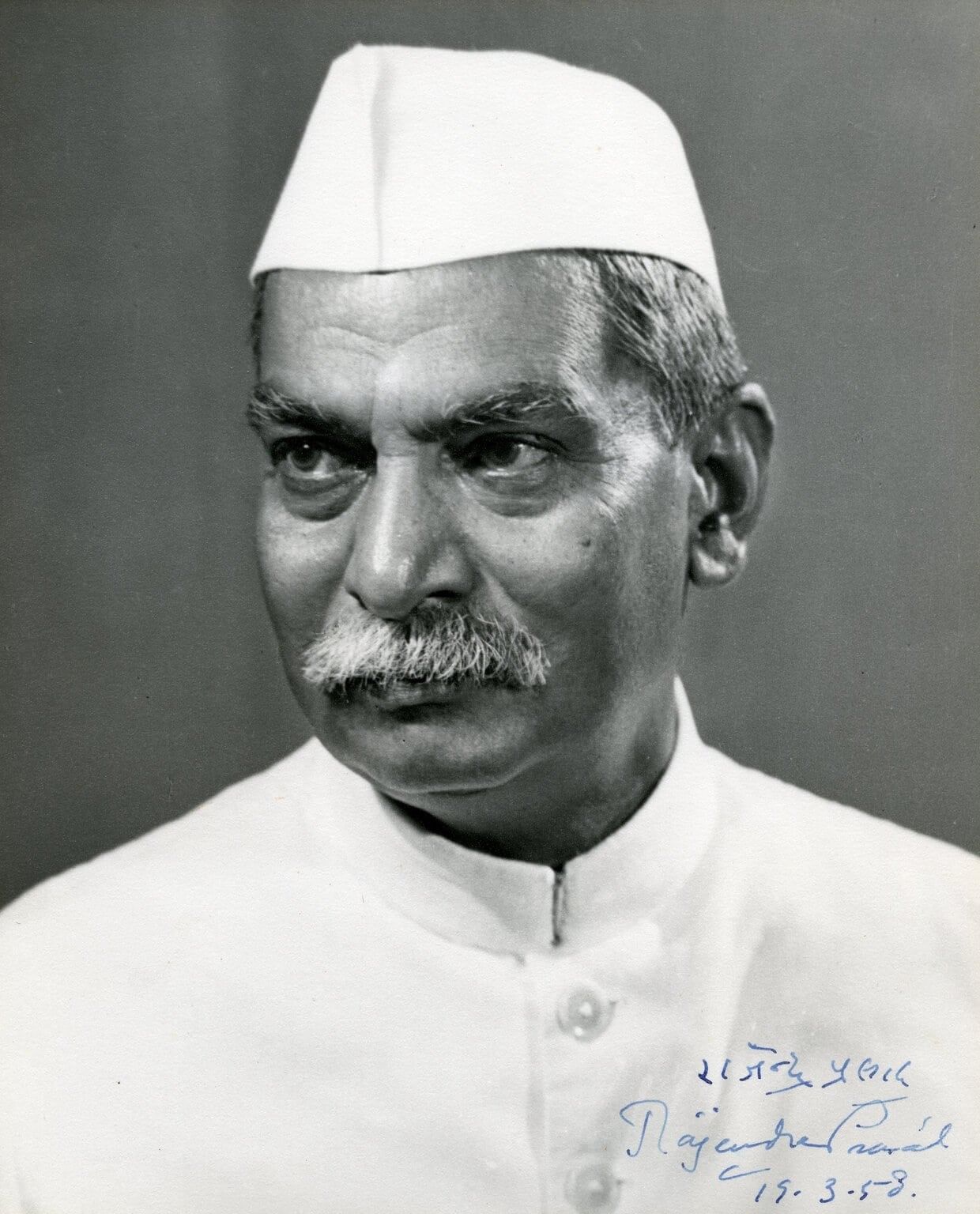 Tribute to Prasad
Tribute to Prasad
Why in News?
On the 62nd death anniversary of Dr. Rajendra Prasad, the Chief Minister of Bihar paid tribute to his remarkable personality and contributions.
Dr. Rajendra Prasad: A Brief Overview
- Birth: Dr. Rajendra Prasad was born on December 3, 1884, in Jiradei, located in the Siwan district of Bihar.
- Early Involvement in National Movement: He actively participated in the Champaran Satyagraha in 1917, opposing the Rowlatt Act of 1918.
- Response to Historical Events: Dr. Prasad strongly reacted to the Jallianwala Bagh massacre in 1919 and called for non-cooperation in Bihar as part of Gandhiji’s Non-Cooperation Movement.
- Continued Activism: He played a significant role in the Salt Satyagraha in Bihar in 1930, which led to his imprisonment.
- Joining the Indian National Congress: Dr. Prasad officially joined the Indian National Congress in 1911 during its annual session in Calcutta.
- Ministerial Role: In 1946, he became the Minister of Food and Agriculture in Pandit Jawaharlal Nehru’s interim government, promoting the “Grow more food” slogan.
- Presidency: He was elected as the first President of India on January 26, 1950, serving for over 12 years, the longest in Indian history.
- Awards and Authorship: Dr. Prasad was awarded the Bharat Ratna in 1962 and authored several books, including “Satyagraha at Champaran,” “India Divided,” and his autobiography.
- Death: He passed away on February 28, 1963.
Bihar Economic Survey 2024-25
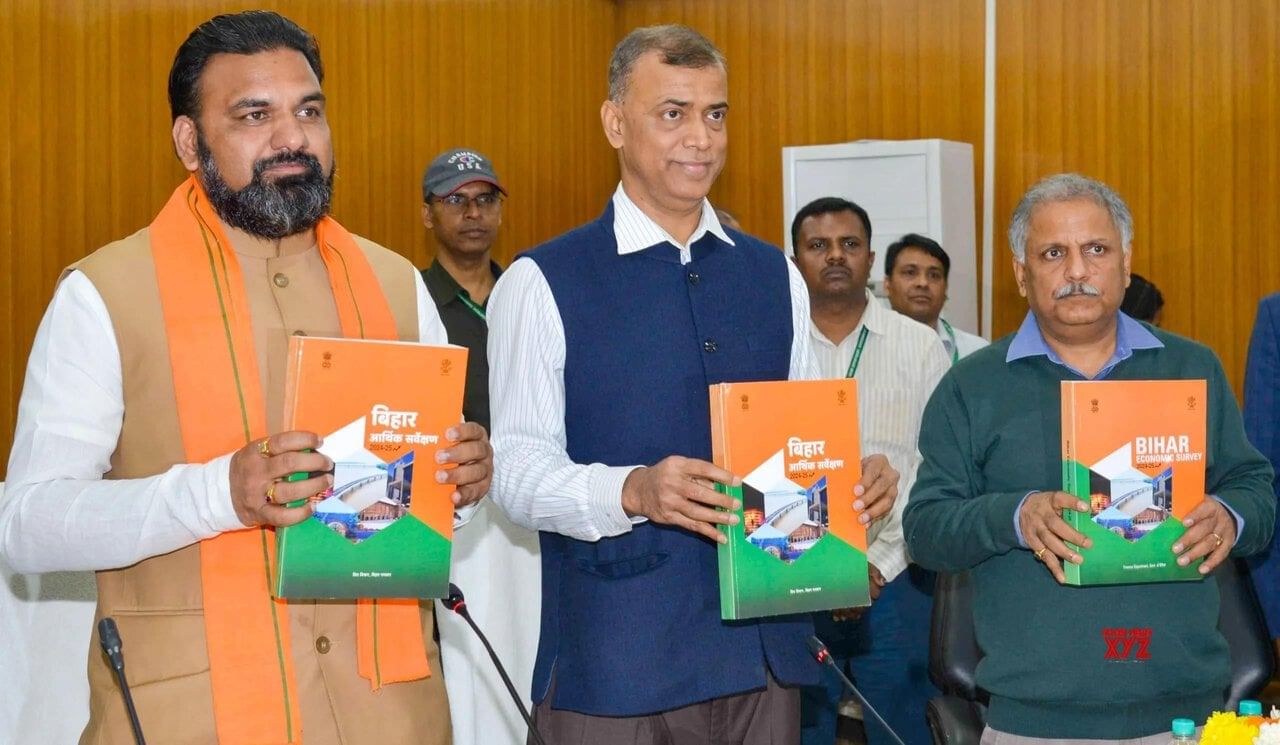
Why in News?
On 28 February 2025, the Finance Minister presented the Bihar Economic Survey 2024-25 in the Assembly. This marks the 19th economic survey of the state, providing an in-depth analysis of Bihar's economy and its development trajectory.
Economic Growth Rate:
- Bihar is the second fastest growing state in India.
- Estimated Gross State Domestic Product (GSDP) for Bihar in 2023-24: Rs 8,54,429 crore (current prices) and Rs 4,64,540 crore (2011-12 constant prices).
- GSDP growth for 2023-24: 14.5% (current prices) and 9.2% (constant prices).
- Per capita income for 2023-24: Rs 36,333 (constant prices) and Rs 66,828 (current prices), showing an increase from the previous year.
- Patna is the wealthiest district, while Sheohar is the poorest in Bihar.
Fiscal Deficit:
- Fiscal deficit reduced from Rs 44,823 crore in 2022-23 to Rs 35,660 crore in 2023-24.
- Estimated fiscal deficit for 2024-25: Rs 29,095 crore.
- Revenue saving: Rs 2,833 crore in 2023-24 and expected Rs 1,121 crore in 2024-25.
- Total expenditure: Rs 2.52 lakh crore in 2023-24, estimated Rs 2.79 lakh crore in 2024-25.
- Development expenditure: estimated to increase from Rs 1.69 lakh crore to Rs 1.77 lakh crore.
Agricultural and Industrial Sector:
- Increase in rice production by 21% and wheat production by 10.7%.
- Livestock and fisheries growth at 9.50%.
- Implementation of the Agricultural Investment Promotion Policy for seven products: makhana, fruits, vegetables, maize, medicinal plants, honey, and tea.
- Proposed Rs 75,293.76 crore investment in the industrial sector.
- Service sector contributes 58.6% to GSDP, followed by industry at 21.5% and agriculture at 19.9%.
- Investment in micro-enterprises: 135% increase, 107% rise in employment.
- Investment in large-scale units: 131% growth, 187% increase in employment.
- Mining sector growth: 9%.
Roads and Infrastructure:
- Rural paved roads increased from 835 km in 2005 to 1.17 lakh km in 2025.
- Expansion of the transport system with new expressways and national highways.
- Bihar recorded the third highest growth in the transport and communication sector (7.6%. during 2011-24.
- Road density: 3,167 per thousand square kilometres, ranking third in India.
Digital Governance and Energy Sector:
- Adoption of technologies like CCTNS, CFMS, and Cyber Cell, promoting e-governance.
- Increase in per capita energy consumption from 134 kilowatt-hours (2012–13) to 363 kilowatt-hours (2023–24).
- Top districts in electricity consumption: Patna, Gaya, Muzaffarpur, Rohtas, and Nalanda.
- Public utility services (water supply, electricity, gas) increased by 14.5%.
Women Empowerment:
- Formation of 1,063.5 thousand Self Help Groups (SHGs).
- Cumulative credit of Rs 46.9 thousand crore to 2,198.4 thousand SHGs.
- Total deposits: Rs 5.27 lakh crore, loans disbursed Rs 2.97 lakh crore, credit-deposit ratio 56.3%.
- Improvement in female labour force participation rate: rural women from 24.8% to 33.5%, urban women from 13.8% to 18% (2022-23 to 2023-24).
- Labour force participation ratio of men and women in Bihar is lower than the national average.
Education and Health Sector:
- Expenditure on education increased 10 times, health 13 times, and social services 13 times in the last 18 years.
- Child welfare budget grew by 19.4% annually between 2016–23.
- Dropout rate in government secondary schools decreased by 62.25% in five years.
Environment and Climate Change:
- Implementation of the Green Jal-Jeevan-Hariyali Mission to address climate change.
- Increase in forest cover by 687 square km over 12 years.
FAQs on BPSC Monthly Current Affairs: March 2025 - Monthly Current Affairs BPSC - BPSC (Bihar)
| 1. What is the significance of the Special Category Rating for states in India? |  |
| 2. How does the Special Category Status impact the funding and development of states like Bihar? |  |
| 3. What criteria are used to determine whether a state qualifies for Special Category Status? |  |
| 4. Can the Special Category Status be revoked or changed? |  |
| 5. What are the potential challenges faced by states with Special Category Status regarding their development? |  |




